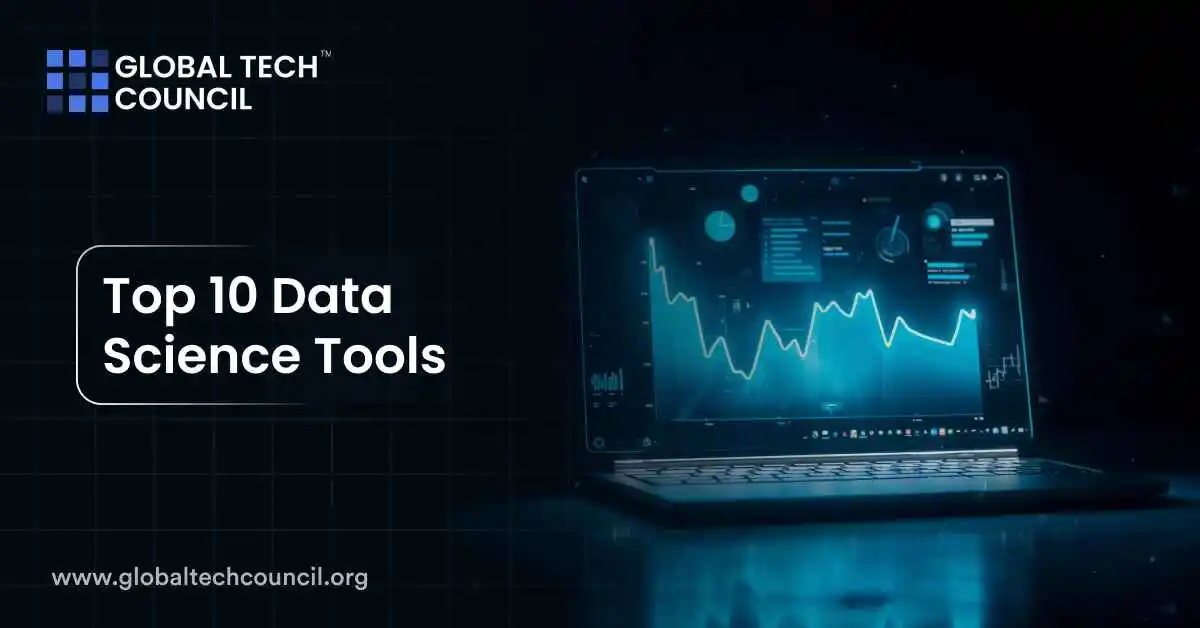 The top 10 data science tools in 2025 are Python, R, Jupyter Notebook, Tableau, Power BI, Apache Spark, TensorFlow, RapidMiner, KNIME, and Google Colab. These tools help data professionals with everything from cleaning data to building predictive models and creating dashboards.
The top 10 data science tools in 2025 are Python, R, Jupyter Notebook, Tableau, Power BI, Apache Spark, TensorFlow, RapidMiner, KNIME, and Google Colab. These tools help data professionals with everything from cleaning data to building predictive models and creating dashboards.
If you’re starting a career in data science or want to improve how your team works with data, these tools are the essentials. In this article, we’ll explain what each tool does, who it’s best for, and how it fits into the modern data science workflow.
1. Python
Python is the most widely used tool in data science. It’s a general-purpose programming language that’s easy to learn and packed with data-friendly libraries like Pandas, NumPy, Matplotlib, and Scikit-learn.
You can use Python for everything — data cleaning, visualization, machine learning, automation, and more. It’s also used in AI development with frameworks like TensorFlow and PyTorch.
Python is flexible, beginner-friendly, and supports large communities.
2. R
R is another powerful language built specifically for statistics and data analysis. It shines in projects where statistical modeling is key, and it offers beautiful plotting packages like ggplot2 and Shiny for visualization.
It’s widely used in academic research, healthcare, and financial sectors.
3. Jupyter Notebook
Jupyter Notebook is a popular tool for writing and running Python code in a browser. It lets you combine code, charts, and explanations in one place.
It’s ideal for data exploration, analysis, and sharing your findings with others. It also supports R and Julia languages.
4. Tableau
Tableau is one of the best tools for creating interactive data dashboards and charts without writing code. It’s great for business users and analysts who want quick insights through drag-and-drop visualizations.
You can connect Tableau to Excel, SQL databases, or live web data and create reports your team can explore in real-time.
5. Power BI
Power BI is Microsoft’s business analytics tool. Like Tableau, it helps users create visual reports, track KPIs, and drill into trends.
It’s tightly integrated with Excel, SharePoint, and Azure, making it a good fit for enterprise teams already using Microsoft products.
6. Apache Spark
Apache Spark is a big data processing engine. It helps you analyze huge datasets across multiple computers without writing complex code.
It supports Python, Scala, and R, and it’s used in projects involving real-time data, large-scale ETL pipelines, or high-speed processing.
7. TensorFlow
TensorFlow is Google’s open-source platform for deep learning. It lets developers build, train, and deploy neural networks, powering everything from speech recognition to computer vision.
If you want to work in AI or advanced machine learning, TensorFlow is a core tool to learn.
8. RapidMiner
RapidMiner is a data science platform that offers a graphical interface for building models. You can drag and drop components to clean data, train models, and evaluate results.
It’s useful for people who don’t want to code but still want to use machine learning.
9. KNIME
KNIME is similar to RapidMiner. It’s an open-source tool that lets you build data workflows visually. It’s used for analytics, data integration, and machine learning.
KNIME is beginner-friendly and good for teams who want consistent processes with less coding.
10. Google Colab
Google Colab is like Jupyter Notebook — but hosted in the cloud. It’s free, supports GPUs, and doesn’t require installation.
It’s great for running Python code, testing machine learning models, or collaborating with teammates online.
Popular Data Science Tool Capabilities
| Tool | Works in Cloud? | Supports ML? | Code-Free Option? |
| Python | Yes | Yes | No |
| R | Yes | Yes | No |
| Jupyter | Yes | Yes | No |
| Tableau | Yes | No | Yes |
| Power BI | Yes | No | Yes |
| Apache Spark | Yes | Yes | No |
| TensorFlow | Yes | Yes | No |
| RapidMiner | Yes | Yes | Yes |
| KNIME | Yes | Yes | Yes |
| Google Colab | Yes | Yes | No |
How These Tools Fit Together
In most real-world projects, you’ll use several tools together. For example, you might:
- Clean your data in Python or R
- Explore trends in Jupyter Notebook
- Train a model using TensorFlow
- Share results in Tableau or Power BI
If you’re managing large-scale data, you might also use Spark for ETL and Colab for fast prototyping.
Choosing the Right Tool
Here’s how to think about choosing the right tool for your goals:
- If you’re new to coding, start with Tableau, Power BI, or RapidMiner
- If you’re learning machine learning, start with Python, Jupyter, and Colab
- If you work with big data, try Apache Spark or KNIME
- If your focus is statistics, R is still a top choice
To build practical skills in these tools, a Data Science Certification can help you move faster. You’ll get guided projects and real-world use cases.
Or if you’re working at the intersection of strategy and data, a Marketing and Business Certification might be a better fit.
For more advanced technical skills, including blockchain data and AI pipelines, visit Blockchain Council for deep tech certifications.
Final Thoughts
The field of data science is growing quickly, and the right tools make a huge difference. Whether you’re coding in Python, building dashboards in Tableau, or scaling with Spark, each tool plays a role in solving modern data challenges.
You don’t need to master all ten right away. Start with one or two based on your needs. Build real projects. Learn what works for you.
The more comfortable you get with these tools, the more valuable you’ll be — no matter your industry.